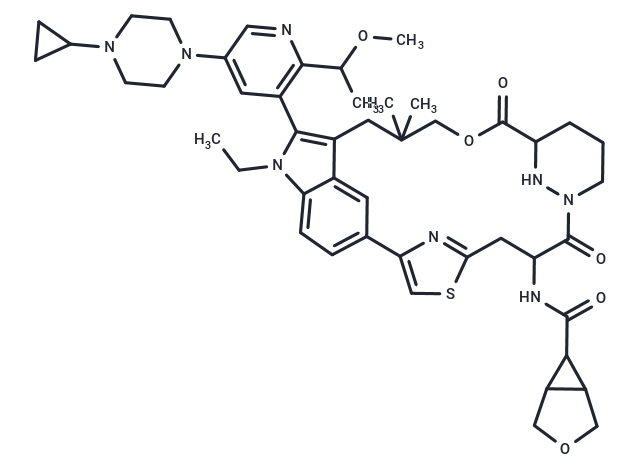Shopping Cart
Remove All Your shopping cart is currently empty
Your shopping cart is currently empty
RMC-7977 is a highly selective inhibitor of the active (GTP-bound) forms of KRAS, HRAS, and NRAS with anticancer activity for the study of solid tumors with KRAS G12C mutations.

| Pack Size | Price | USA Warehouse | Global Warehouse | Quantity |
|---|---|---|---|---|
| 1 mg | $257 | In Stock | In Stock | |
| 5 mg | $645 | In Stock | In Stock | |
| 10 mg | $987 | In Stock | In Stock | |
| 25 mg | $1,530 | In Stock | In Stock | |
| 50 mg | $1,980 | In Stock | In Stock | |
| 100 mg | $2,790 | In Stock | In Stock | |
| 1 mL x 10 mM (in DMSO) | $986 | In Stock | In Stock |
| Description | RMC-7977 is a highly selective inhibitor of the active (GTP-bound) forms of KRAS, HRAS, and NRAS with anticancer activity for the study of solid tumors with KRAS G12C mutations. |
| In vitro | METHODS: U2OS cells were treated with 50 nM RMC-7977 to observe the formation of KRAS-CYPA complexes and disruption of KRAS(G12V)-CRAF interactions using a live-cell nano-bioluminescence resonance energy transfer (BRET) kinetic assay.
RESULTS: RMC-7977 induced KRAS and CYPA binding and dissociated the CRAF RBD from KRAS at the same fast rate (signaling half-life (t1/2) < 5 min).[1] METHODS: RAS-dependent (KRAS, NRAS, or EGFR mutated) cancer cells treated with RMC-7977 (0.1,1,10,100,100 nM) were compared for activity of RMC-7977 in cancer cells harboring various activating mutations in the RAS pathway, specifically oncogenic variants of KRAS, NRAS, EGFR, or BRAF. RESULTS: Exhibited concentration-dependent inhibition of downstream signaling and proliferation in the low nanomolar range.[1] |
| In vivo | METHODS: U2OS cells were treated with 50 nM RMC-7977 to observe the formation of KRAS-CYPA complexes and disruption of KRAS(G12V)-CRAF interactions using a live-cell nano-bioluminescence resonance energy transfer (BRET) kinetic assay.
RESULTS: RMC-7977 induced KRAS and CYPA binding and dissociated the CRAF RBD from KRAS at the same fast rate (signaling half-life (t1/2) < 5 min).[1] METHODS: RAS-dependent (KRAS, NRAS, or EGFR mutated) cancer cells treated with RMC-7977 (0.1,1,10,100,100 nM) were compared for activity of RMC-7977 in cancer cells harboring various activating mutations in the RAS pathway, specifically oncogenic variants of KRAS, NRAS, EGFR, or BRAF. RESULTS: Exhibited concentration-dependent inhibition of downstream signaling and proliferation in the low nanomolar range.[1] |
| Molecular Weight | 865.09 |
| Formula | C47H60N8O6S |
| Cas No. | 2765082-12-8 |
| Smiles | O=C1OCC(C)(C)CC=2C3=CC(=CC=C3N(C2C=4C=C(C=NC4C(OC)C)N5CCN(CC5)C6CC6)CC)C=7N=C(SC7)CC(NC(=O)C8C9COCC89)C(=O)N%10NC1CCC%10 |
| Storage | store at low temperature,keep away from moisture | Powder: -20°C for 3 years | In solvent: -80°C for 1 year | Shipping with blue ice/Shipping at ambient temperature. | |||||||||||||||||||||||||||||||||||
| Solubility Information | DMSO: 120 mg/mL (138.71 mM), Sonication is recommended. | |||||||||||||||||||||||||||||||||||
Solution Preparation Table | ||||||||||||||||||||||||||||||||||||
DMSO
| ||||||||||||||||||||||||||||||||||||
| Size | Quantity | Unit Price | Amount | Operation |
|---|

Copyright © 2015-2026 TargetMol Chemicals Inc. All Rights Reserved.